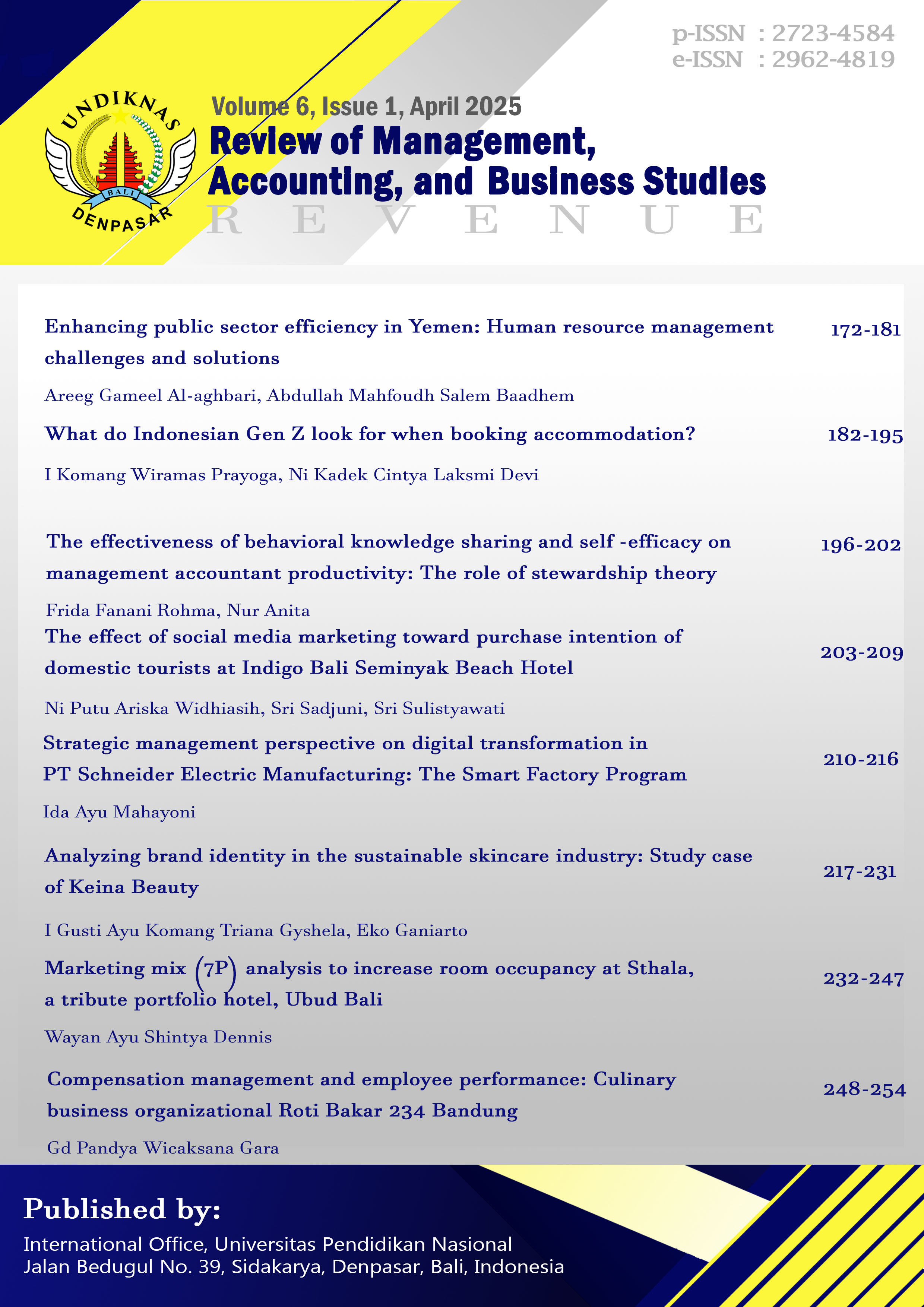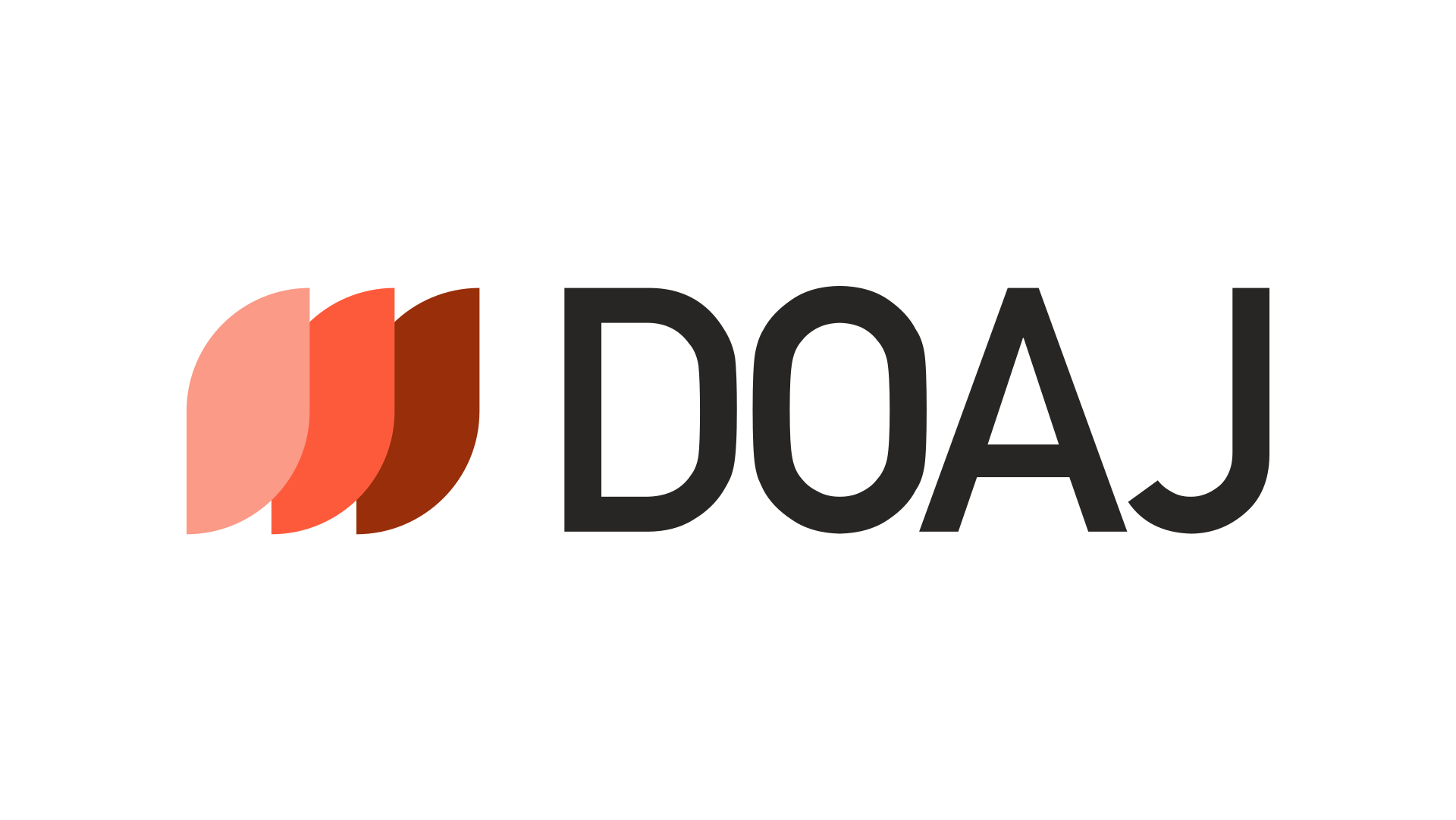Enhancing public sector efficiency in Yemen: Human resource management challenges and solutions
DOI:
https://doi.org/10.38043/revenue.v6i1.6128Keywords:
Public Sector , HRM , Challenges , Solutions . Yemen.Abstract
Yemen's public sector has long struggled with governance deficiencies, bureaucratic inflexibility, and institutional inefficiencies—all of which have been made considerably worse by years of conflict and economic downturn. The strategic use of human resource management (HRM) to improve public sector efficiency in Yemen is critically examined in this research, with an emphasis on the implementation of e-government programs and HRM-driven reforms. To demonstrate how HRM shortcomings in hiring, training, performance management, and employee retention have directly led to systemic breakdowns in service delivery, the study synthesizes empirical data from the transportation, health, education, and food security sectors, drawing on a narrative literature review. The study emphasizes the discrepancy between HRM rules and real administrative results, highlighting the pressing need for merit-based, context-specific, and technology-enabled HRM practices. The results indicate that Yemen's recovery, governance transformation, and development goals will remain unachievable in the absence of extensive institutional reforms, especially in HRM. Strategic suggestions for restoring HR capability, encouraging accountability, and utilizing technology to support sustainable government in Yemen following the crisis.
References
Articles
Abdullah, Md. F., Shaban Jamal Ayyat, & Bahyah Binti Abdul Halim. (2021). Challenges of human resource management in Palestine. The Journal of Management Theory and Practice (JMTP), 17–22. https://doi.org/10.37231/jmtp.2021.2.4.122
Al-Hattami, H. M., & Kabra, Jawahar. D. (2019). The role of accounting information system (AIS) in rationalizing human resource related decisions: A case study of selected commercial banks in Yemen. International Journal of Management Studies, VI(2), 84. https://doi.org/10.18843/ijms/v6si2/12
Almekhlafi, H. M. O. (2023). Yemen’s public sector transformation: Unpacking the dynamics of assessing organizational culture, leadership Approaches and employees adherence to change. International Journal of Science and Business, 28(1), 170–182. https://doi.org/10.58970/IJSB.2212
Al-Saidi, M. (2020). Legacies of state-building and political fragility in conflict-ridden Yemen: Understanding civil service change and contemporary challenges. Cogent Social Sciences, 6(1). https://doi.org/10.1080/23311886.2020.1831767
Arulrajah, A. A. (2016). Literature Review on Good Governance in the Organizations through Human Resource Management: A Corporate Level Analysis. International Business Research, 9(8), 14. https://doi.org/10.5539/ibr.v9n8p14
Barahma, M. M., ALi, K. B., Nashief, M., & Al-Awlaqi, M. A. (2019). The Impact OF Human Resources Management Strategies on the Strategic Agility: A Field Study in large and medium Yemeni manufacturing Sector. Journal of Social Sciences (COES&RJ-JSS), 8(4), 611–629. https://doi.org/10.25255/jss.2019.8.4.611.629
Basloom, R. S., Sani Mohamad, M. H., & Auzair, S. M. (2022). Applicability of public sector reform initiatives of the Yemeni government from the integrated TOE-DOI framework. International Journal of Innovation Studies, 6(4), 286–302. https://doi.org/10.1016/j.ijis.2022.08.005
Braun, V., & Clarke, V. (2006). Using thematic analysis in psychology. Qualitative Research in Psychology, 3(2), 77–101. https://doi.org/10.1191/1478088706qp063oa
Brawijaya, U., Widya Kusuma, E., & Rasyidah, R. (2021). Pandemi dan pemenuhan hak anak: studi kasus peran UNICEF di Yaman pada masa COVID-19. In Jurnal Transformasi Global (Vol. 8, Issue 2).
Clausen, M. L. (2020). Decentralization as a strategy of regime maintenance: The case of Yemen. Public Administration and Development, 40(2), 119–128. https://doi.org/10.1002/pad.1880
Elayah, M., Al-Sameai, N., Khodr, H., & Gamar, S. (2024). Community-based initiatives and public services delivery in a fragile context: The case of Yemen. Nonprofit and Voluntary Sector Quarterly, 53(1), 5–28. https://doi.org/10.1177/08997640221145182
Fanan Simplicious Ongina, Samuel Omacar, & Muhammad SSendagi. (2024). Human resource recruitment and employees’ performance in the national ministry of public service in Juba-South Sudan. SJ Business Research Africa. https://doi.org/10.51168/sjbusiness.v1i1.28
Fenwick, A., Molnar, G., & Frangos, P. (2023). Revisiting the role of HR in the age of AI: bringing humans and machines closer together in the workplace. In Frontiers in Artificial Intelligence (Vol. 6). Frontiers Media SA. https://doi.org/10.3389/frai.2023.1272823
Flaeming, T., Hoogeveen, J., Klytchnikova, I., Krishnan, N., Pape, U., Piffaretti, N., Salisbury, P., Favari, E., Geiger, M., Krishnaswamy, S., & Tandon, S. (2021). The 2020 food security crisis in Yemen 1. World Bank Group. NW, Washington, DC.
Gaghman, A. (2020). The Importance of good governance on achieving sustainable development case study: Yemen. KnE Social Sciences. https://doi.org/10.18502/kss.v4i1.5987
Gogtay, N. J., & Thatte, U. M. (2017). Principles of correlation analysis. In Journal of The Association of Physicians of India (Vol. 65).
Green, B. N., Johnson, C. D., & Adams, A. (2006). Writing narrative literature reviews for peer-reviewed journals: secrets of the trade. Journal of chiropractic medicine, 5(3), 101–117. https://doi.org/10.1016/S0899-3467(07)60142-6
Grindle, & Hilderbrand. (1995). Building sustainable capacity in the public sector: What can be done? Public Administration and Development, 15(5), 441–463. https://doi.org/https://doi.org/10.1002/pad.4230150502
Hartley, J., Alford, J., Knies, E., & Douglas, S. (2017). Towards an empirical research agenda for public value theory. Public Management Review, 19(5), 670–685. https://doi.org/10.1080/14719037.2016.1192166
Hazaea, S. A., Tabash, M. I., Zhu, J., Khatib, S. F. A., & Betami, H. A. (2022). Corruption and supreme audit institutions in the Yemeni public sector: An empirical investigation. Public Administration Issues, 5, 87–109. https://doi.org/10.17323/1999-5431-2022-0-5-87-109
Isaac, O., Abdullah, Z., Ramayah, T., & Mutahar, A. M. (2017). Internet usage, user satisfaction, task-technology fit, and performance impact among public sector employees in Yemen. International Journal of Information and Learning Technology, 34(3), 210–241. https://doi.org/10.1108/IJILT-11-2016-0051
John Festus Vandy. (2023). The critical examination of the new public sector management in view of hrm – the critical success factors. World Journal of Advanced Research and Reviews, 18(2), 109–115. https://doi.org/10.30574/wjarr.2023.18.2.0776
Knies, E., Boselie, P., Gould-Williams, J., & Vandenabeele, W. (2024). Strategic human resource management and public sector performance: Context matters. In International Journal of Human Resource Management (Vol. 35, Issue 14, pp. 2432–2444). Routledge. https://doi.org/10.1080/09585192.2017.1407088
Krishnan, P. (2024). An integrated strategic architectural framework for AI-Augmented HRM. International Journal of Science and Research (IJSR), 13(10), 183–192. https://doi.org/10.21275/SR241001224937
Latifi, K. A. N., & Lim, S. (2019). Strategic human resource management in the Afghanistan Ministry of Mines and Petroleum: A network perspective. Sustainability (Switzerland), 11(14). https://doi.org/10.3390/su11143830
Malik, A., Budhwar, P., & Kazmi, B. A. (2023). Artificial intelligence (AI)-assisted HRM: Towards an extended strategic framework. In Human Resource Management Review (Vol. 33, Issue 1). Elsevier Ltd. https://doi.org/10.1016/j.hrmr.2022.100940
Moini, J. F. D. (2020). The challenges faced by human resource practitioners in implementing strategic human resource management in South Sudan National Organizations: Case study Jubek State. TEXILA International Journal of Academic Research, 7(1), 127–133. https://doi.org/10.21522/tijar.2014.07.01.art012
Parimalam, & Dhanabagiyam. (2023). Strategic role of artificial intelligence and the power of eHRM for innovative human resource management. Asian Journal of Management, 14(3), 207–210.
Shaker M. Al-Kahtani. (2021). The role of human resources management in improving the institutional performance of medium industrial companies in the Republic of Yemen. Albaydha University Journal, 3(2), 932–942. https://doi.org/10.56807/buj.v3i2.187
Shouran, Z., & Abbas Ali, D. (2024). The implementation of artificial intelligence in human resources management. Journal of International Conference Proceedings 7(1), 244–258. https://doi.org/10.32535/jicp.v7i1.299
Trabelsi, N., & Boujelbene, Y. (2024). Public Sector Efficiency and Economic Growth in Developing Countries. Journal of the Knowledge Economy, 15(1), 596–615. https://doi.org/10.1007/s13132-022-01038-2
Valerio, A. S. (2024). Enhancing Good Governance through Strategic Human Resource Management: A Case Study of Zamboanga City, Philippines. Cognizance Journal of Multidisciplinary Studies, 4(6), 425–440. https://doi.org/10.47760/cognizance.2024.v04i06.026
Vandy, J. F. (2023). The critical examination of the new public sector management in view of HRM – the critical success factors. World Journal of Advanced Research and Reviews, 18(2), 109–115. https://doi.org/10.30574/wjarr.2023.18.2.0776
Yadava, A. K., & Neog, Y. (2022). Public sector performance and efficiency assessment of Indian States. Global Business Review, 23(2), 493–511. https://doi.org/10.1177/0972150919862664
Books
Muthanna, A., Alduais, A., & Ghundol, B. (2022). Challenges facing teacher education in Yemen: Toward better quality. Springer Nature. https://doi.org/10.1007/978-981-19-2400-2_24
Reports
Al-Tairi, N. (2022). The road transport sector in Yemen: critical issues and priority policies. https://devchampions.org/uploads/publications/files/Rethinking_Yemens_Economy_No11_En-1.pdf
International Monetary Fund. (2001). Republic of Yemen: Staff report. International Monetary Fund.
Rethinking Yemen’s Economy. (2019). Inflated beyond fiscal capacity: The need to reform the public sector wage bill. http://pubdocs.worldbank.org/en/365711553672401737/Yemen-
UNICEF. (2021). Education disrupted: Impact of the conflict on children’s education in Yemen. UNICEF
World Bank. (2023). Yemen country economic memorandum 2022: Glimmers of hope in dark times. https://openknowledge.worldbank.org/handle/10986/39914
World Health Organization. (2024). Yemen WHO 2024 Health Emergency Appeal. https://cdn.who.int/media/docs/default-source/documents/emergencies/2024-appeals/yemen---who-2024-health-emergency-appeal.pdf?sfvrsn=686c454b_1&download=true
Thesis
Abbad, I. B., Abdulsalam, I., & Abbad, B. (2024). Challenges of local public administration in conflict -affected countries: Case of Hadhramaut Governorate in Yemen [Master’s thesis, The American University in Cairo]. https://fount.aucegypt.edu/etds/2303
Web Pages
Khaled, F. (2024). A war of attrition: Higher education in Yemen. Retrieved from https://sanaacenter.org/publications/main-publications/22091
Reliefweb. (2024). Hanging in the Balance: Yemeni Children’s Struggle for Education. Retrieved from https://reliefweb.int/report/yemen/hanging-balance-yemeni-childrens-struggle-education
UNICEF. (2024). UNICEF Yemen: Bridging the education gap of children displaced by conflict in Yemen. Retrieved from https://www.unicef.org/yemen/stories/bridging-education-gap-children-displaced-conflict-yemen
WFP. (2024). WFP Yemen Food Security Update, February 2024. Retrieved from file:///C:/Users/MSII/Downloads/Food%20security%20update%20Feb%202024.pdf
Downloads
Published
How to Cite
Issue
Section
License
Copyright (c) 2025 Areeg Gameel Al-aghbari, Abdullah Mahfoudh Salem Baadhem

This work is licensed under a Creative Commons Attribution-ShareAlike 4.0 International License.











